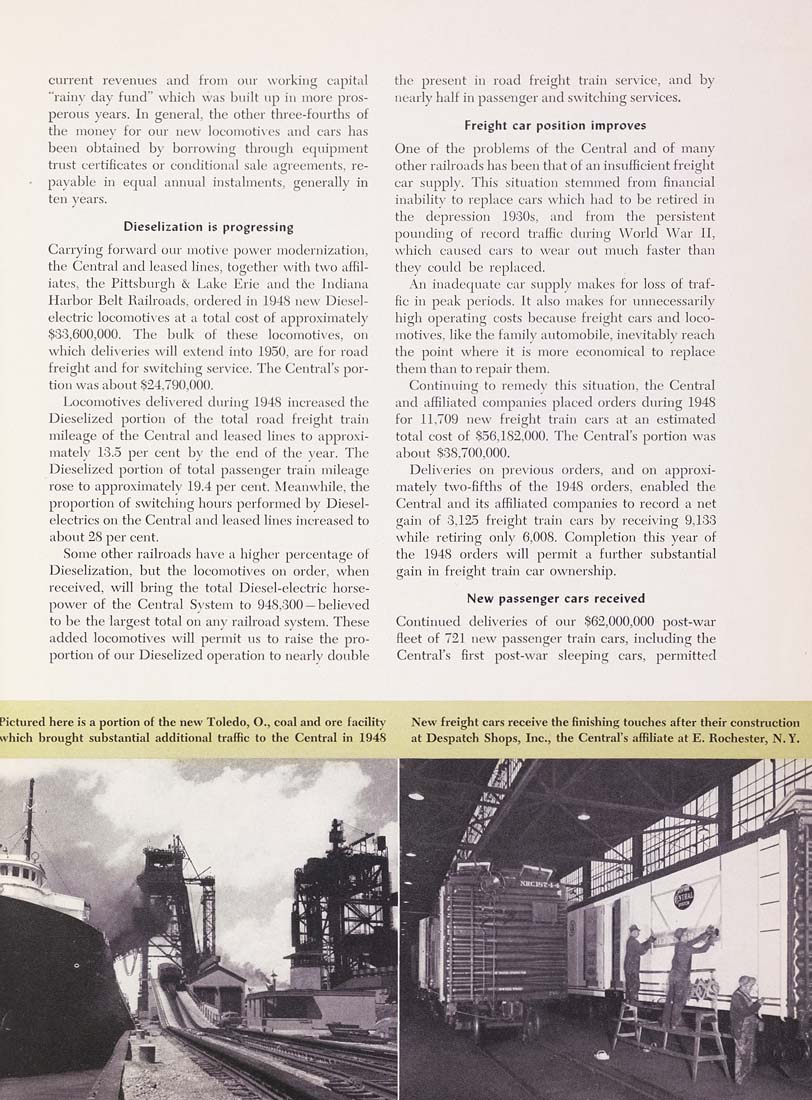current re\"enues and from our working capital
"rainy day fund" which was built up in more pros¬
perous years. In general, the other three-fourths of
the money for our new locomoti\"es and cars has
been obtained by borrowing through equipment
trust certificates or conditional sale agreements, re¬
payable in equal annual instalments, generally in
ten years.
Dieselization is progressing
Carrying forward our motl\ c power modernization,
the Central and leased lines, together with two affil¬
iates, the Pittsburgh & Lake Erie and the Indiana
Harbor Belt Railroads, ordered in 1948 new Diesel-
electric locomoti\es at a total cost of approximately
$33,600,000. The bulk of these locomotives, on
which deli\'eries will extend into 1950, are for road
freight and for switching service. The Central's por¬
tion was about $24,790,000.
Locomotives delivered during 1948 increased the
Dieselized portion of the total road freight train
mileage of the Central and leased lines to approxi¬
mately 13.5 per cent by the end of the vear. The
Dieselized portion of total passenger train mileage
rose to approximately 19.4 per cent. Meanwhile, the
proportion of switching hours performed by Diesel-
electrics on the Central and leased lines increased to
about 28 per cent.
Some other railroads have a higher percentage of
Dieselization, but the locomotives on order, when
received, will bring the total Diesel-electric horse¬
power of the Central System to 948,300 — believed
to be the largest total on any railroad svstem. These
added locomotives will permit us to raise the pro¬
portion of our Dieselized operation to nearlv double
the present in road freight train ser\icc, and by
nearly half in passenger and switching services.
Freight car position improves
One of the problems of the Central and of many
other railroads has been that of an insufficient freight
car supply. This situation stemmed from financial
inabilitv to replace cars which had to be retired in
the depression 1930s, and from the persistent
pounding of record traffic diuing World War 11,
which caused cars to wear out much faster than
they could be replaced.
An inadequate car supply makes for loss of traf¬
fic in peak periods. It also makes for unnecessarily
high operating costs because freight cars and loco¬
motives, like the family automobile, inevitably reach
the point where it is more economical to replace
them than to repair them.
Continuing to remedv this situation, the Central
and affiliated companies placed orders during 1948
for 11,709 new freight train cars at an estimated
total cost of $56,182,000. The Central's portion was
about 838,700,000.
Deli\'eries on previous orders, and on approxi¬
mately two-fifths of the 1948 orders, enabled the
Central and its affiliated companies to record a net
gain of 3,125 freight train ears by receiving 9,133
while retiring only 6,008. Completion this year of
the 1948 orders will permit a further substantial
gain in freight train car ownership.
New passenger cars received
Continued deliveries of our $62,000,000 post-war
fleet of 721 new passenger train ears, including the
Central's first post-war sleeping ears, permitted
Pictured here is a portion of the new Toledo, O., coal and ore facility
which brought substantial additional traffic to the Central in 1948
New freight cars receive the finishing touches after their construction
at Despatch Shops, Inc., the Central's affiliate at E. Rochester, N. Y.
•r*i
|








